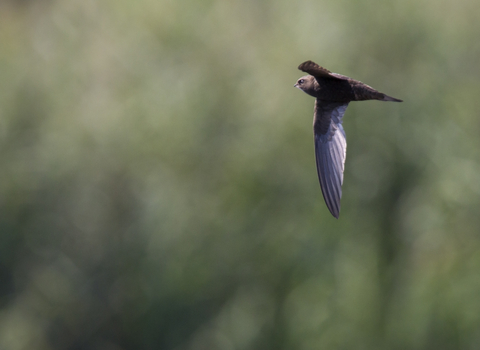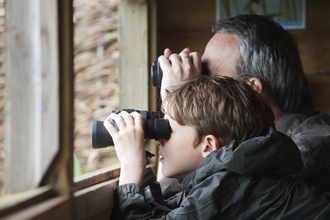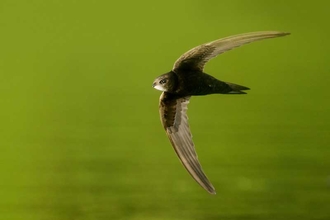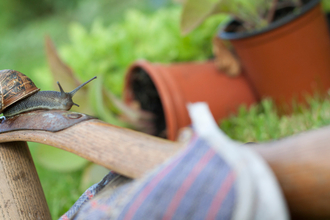Swifts are declining, but it's not too late.
The swift is one of our most beloved summer visitors. As they soar over towns and villages in search of nesting spaces amonst buildings, their scimitar silhouettes and screaming calls fill our skies; giving us one of the most evocative sights and sounds of summer.
But in some places their calls have sadly fallen silent. Over the last 30 years, swift numbers in Suffolk have halved – and this is happening across much of the UK as developments in construction, renovation and insulation are closing off swift nest sites, with devastating results.
That's where Save Our Suffolk (SOS) Swifts comes in.
Our five-point plan to save Suffolk's swifts:
1 - Protect traditional nesting spaces
When you come round to repairs, maintenance or upgrades to your roof, talk to the builders to ensure that space is left for the birds. Under pantiles, through holes in the eaves in soffit and fascia boards, the swift has learnt to find safe gaps. They normally prefer to be at least 4 or 5 metres up with a clear flight in on the northern and easterly aspects. So take time this summer [May to July] to see if birds are swooping up into your roof space.
Once you are looking, check out your neighbours, other streets and especially community buildings such as schools, libraries, town halls and churches. A quiet word in the right ear can then ensure they are aware of the need to also be vigilant when change happens.
Swifts are very neat nesters with little impact on us. Unlike houses martins, there are no piles of droppings outside and their small nest of feathers and dried plant material is kept neat and tidy.
2 - Create new nesting spaces
Nesting boxes are enjoyed by swifts. Fitted in similar spaces at roof level at least 4-5 metres up with a clear flight line in and out, there are a variety of designs to suit all situations. From simple marine-ply boxes to more elaborate cedar and woodcrete, they can go under the eaves, up the tower, on the factory wall or wherever there is suitable space. Swifts are gregarious birds so putting up two or a series of boxes will also be welcome.
An S-Brick can be made to match brickwork, render and cladding and tailored for the different cavity widths. BS42021 is the new building standard for nest bricks.
They are best fitted in groups of 3 or more on high gables of a house (10-40 on a large public building), above the insulation line backing onto a cold void where there is a clear line of flight
Nest bricks can be purchased locally from ActionForSwifts actionforswifts@gmail.com.
Searching on the internet will show you the range of options and sources available. One prolific box maker is John Stimpson in Cambridgeshire – details here. We are hoping to increase options locally and you may like to contact the Street Forge Workshop, in Thornham Magna (tel 01379 678543) who produce a cedar version with a slate roof.
Click here for instructions on how to make your own swift box. Discounted plywood is available at a ‘Suffolk Bird Group’ discount if you mention the group when ordering from Huws-Gray Ridgeons at Halesworth (tel 01986 875000). They charge £19.80 +VAT per sheet of 12mm external ply and £1.98 +VAT per metre for 6x1” sawn [Apr20].
Ideally boxes want to be up before the birds return in May but there is no harm in putting up boxes at any time of year, as long as you do not disturb other nesters of course.
Please take time to consider the best and safest way of putting up your next boxes and call system. Although we offer encouragement and advice, it is up to you to do this responsibly and safely. All ladder work has risks and the boxes can seem heavy at the top of a ladder. You may be able to seek help from a local builder or tree surgeon! If you are not sure seek further experienced help before acting.
3 - Attract swifts to new nesting spaces by playing swift calls
When swifts have not previously colonised a nest site, it is very important to play swift calls to advertise its existence. Playing their calls mimics the low-level screeching party behaviour that swifts perform around existing nest sites and hugely increases the likelihood that the boxes will be used. There are several groups of potential occupants who may be attracted by the calls:
- Adult birds that have lost a previous nest site and are looking for new sites
- Three year old juveniles looking for a nest site for the following year
- Birds from an over-crowded colony nearby
Birds attracted by the calls will investigate any openings: this is called ‘banging’. The birds will momentarily land and peer in. They may even start to drag in nesting material: aerial debris of grass, leaves and feathers gathered on the wing and cemented together with saliva.
One simple way to play calls is through a Bluetooth speaker placed on the windowsill closest to your nest boxes, connected to a mobile phone or iPod/MP3 player. An easy alternative is to play a CD through a hi-fi speaker or even car stereo. The calls can be purchased cheaply from the Swift-Conservation.org website. Bespoke call systems, such as those supplied by Peak Boxes, are best installed at the same time as the boxes. The speaker will need to be positioned beneath one of the boxes with the cable threaded through to a point inside, close to a power source.
More info on playing calls here
The best times to play the calls is from early May until the end of July. Between 7am and 9am and from 7pm until dusk are the optimal times, but play more frequently if you are not disturbing anyone. Don’t bother during wet or windy weather as the birds don’t prospect then.
4 - Boost insect life by creating wildlife-friendly gardens and community spaces
No matter what size your garden, or even if you only have a window box, choosing wildlife friendly plants and practices can increase insect numbers. Swifts pick up their food in the air as insects fly, or drift, high. Insects need somewhere to breed – with many larvae using particular plants – and then to feed. We are all starting to learn of the need for nectar rich plants for pollinators like bees but don’t forget the value of grasses and other plants that may be food for larvae. There are numerous wildlife gardening books to search for details – or just look out locally for where insects are thriving and get similar plants: they are likely to be adapted to your soil as well.
A pond can be an ideal insect haven. With open water and emergent plants at the side – and a boggy bit – many species can be catered for. But if space is at a premium even an unturned dustbin lid with some water and plants kept topped up during the summer can help.
Try also to cut out the use of pesticides in the garden (and house if you can bare it!) The buzzing of flies or ant swarms can be annoying but they are the vital food for so many other creatures that putting up with them a bit more can help ensure our insect eaters can thrive.
5 - Celebrate and enjoy swifts visiting in summer
All these extra efforts needs to be rewarded: watching the aerial mastery of swifts is one of the British summer's greatest wildlife spectacles.
Try and spot the day they arrive locally (around the start of May) and then watch them prospect for nest sites. Early in the morning (7ish) and the late afternoon and evening should be when they are particularly around our settlements. They can fly hundreds of miles looking for food at the height of the breeding season but should be back to roost at the nest site over-night.
As the season progresses the ‘screaming parties’ will build up. Teams of swifts chasing around the roof tops with their excited screams is for many a typical sound of a hot summer evening. Admire their speed and manoeuvrability. For a real challenge, try counting them!
Taking time to watch and follow their arrival and pattern of life helps value them and brings a bit of pleasure to life. As you get ‘into them’ why not share the pleasure with friends and relatives. Many communities have tried ‘a swift walk and pint’ on a summer evening. Where enthusiasts get together there are now ‘swift streets’ and even ‘swift towns’ where the whole community is enjoying their local wildlife.
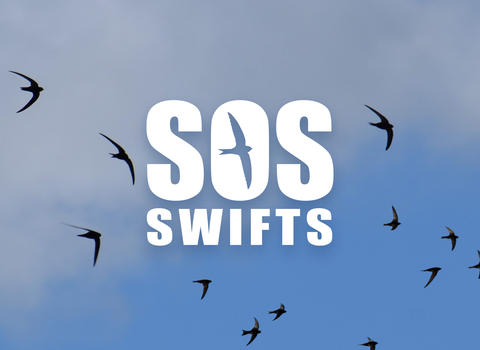
SOS Swifts is a joint project between Suffolk Wildlife Trust and Suffolk Bird Group.
Together, we're delivering targeted action to help save our beloved swifts by protecting, restoring, and creating nest spaces, supporting local communities to become more swift-friendly, and campaigning for developers and planners to integrate swift nesting spaces.
How you can help swifts
There are lots of ways you help swifts at home, at work, or with your local community. There are a growing number of towns and villages wanting to help swifts and are setting up local swift groups. If you would like to know if there's a swift group near you – or are interesting in starting a group yourself - please email: swifts@suffolkbirdgroup.org
Make a donation
FAQs & useful links:
I have found a grounded swift, what do I do?
Caring for a downed swift is a difficult task, both time-consuming and high-risk. There are a few dedicated specialist carers who can help and have successfully released many birds over the years after rehabilitation. Visit swift-conservation.org for more information.
Here are some dos and don'ts:
- DO put the bird in a quiet, warm safe place away from disturbance. On a tea-towel in a ventilated shoebox is excellent.
- DO offer the swift a drunk by wiping a wet cotton bud around the edge of the bill and keeping away from its nostrils.
- DO phone your nearest swift carer ASAP to arrange collection or delivery of the bird. Visit swift-conservation.org/SwiftFirstAid to find a swift carer.
- DO NOT attempt to feed the bird.
- DO NOT throw the bird up to help it fly, this generally causes more stress and injury.
Where can I buy a swift box?
If you are part of a local swift or wildlife group - or are looking to set on up - we may be able to give you a set of swift nest boxes. You can then sell these locally returning a set amount of money so they can replenish stocks and help another group. Contact swifts@suffolkbirdgroup.org in the first instance.
If you're confidend with DIY, you could make your own swift box by downloading and following our guide:
VIDEO: How to identify swifts, swallows and martins
In this short video, environmentalist Simon Hooton explains how to tell the difference between swifts, swallows, house martins, and sand martins.
VIDEO: How to prepare for the return of swifts
In this short video, environmentalist Simon Hooton explains how to you can make your garden or outdoor space a welcoming place for swifts returning from migration.

